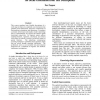Free Online Productivity Tools
i2Speak
i2Symbol
i2OCR
iTex2Img
iWeb2Print
iWeb2Shot
i2Type
iPdf2Split
iPdf2Merge
i2Bopomofo
i2Arabic
i2Style
i2Image
i2PDF
iLatex2Rtf
Sci2ools
AAAI
2008
2008
Knowledge-Based Spatial Reasoning for Scene Generation from Text Descriptions
This system translates basic English descriptions of a wide range of objects in a simplistic zoo environment into plausible, three-dimensional, interactive visualizations of their positions, orientations, and dimensions. It combines a semantic network and contextually sensitive knowledge base as representations for explicit and implicit spatial knowledge, respectively. Its linguistic aspects address underspecification, vagueness, uncertainty, and context with respect to intrinsic, extrinsic, and deictic frames of spatial reference. The underlying, commonsense reasoning formalism is probability-based geometric fields that are solved through constraint satisfaction. The architecture serves as an extensible test-and-evaluation framework for a multitude of linguistic and artificialintelligence investigations.
AAAI 2008 | Implicit Spatial Knowledge | Intelligent Agents | Sensitive Knowledge Base | Simplistic Zoo Environment |
| Added | 02 Oct 2010 |
| Updated | 02 Oct 2010 |
| Type | Conference |
| Year | 2008 |
| Where | AAAI |
| Authors | Dan Tappan |
Comments (0)

